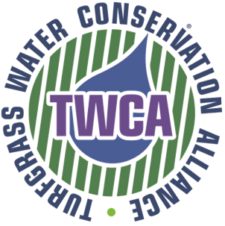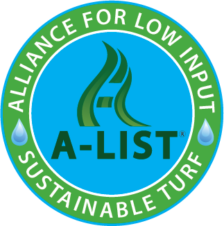Mow higher (1-2 inches), mow regularly, and leave the clippings
“Grasscycling” or leaving the clippings on the lawn doesn’t cause thatch build up. It makes lawns healthier. Soil organisms recycle the clippings into free fertilizer, and you save the work of bagging. Modern mulching lawn mowers make grasscycling even easier.
Use “natural organic” or “slow release” fertilizers
Don’t try for a deep blue-green color – healthy lawns in our region are a lighter meadow green.
- The best time to fertilize is September, when grass plants are building root reserves for the next year.
- If you want to fertilize in spring, wait until May, when grass growth slows.
Water deeply, but less frequently
Let the soil dry between waterings to prevent lawn disease and save water. Lawns only need about one half-inch of water a week in summer, including rain, to stay green.
How much is one half-inch of water a week?
Scatter tuna cans or other straight-sided containers on your lawn, turn on the sprinkler, and check the time. When most cans have one half-inch of water in them, turn off the sprinkler and check how long it ran. Then you know how long to run your sprinkler each week in summer, if you want to keep your lawn green.
Or let lawns go brown and dormant – they’ll bounce back in fall!
You can let lawn areas that don’t get heavy wear go brown and dormant – just water once a month, and they’ll bounce back in the fall. If you end up with thin areas from wear, when it rains in the fall you can rake to expose the soil, then overseed (see below).
Use automatic irrigation systems efficiently
Automatic systems can waste lots of water, or be efficient, depending on how you set and maintain them.
- Have a professional test, repair, and adjust your system annually.
- Inspect the system while operating once a month – look for leaks or heads that are plugged or misdirected.
- Install a rain shutoff device (ask your irrigation expert where to find them).
- Adjust the watering schedule at least once a month through the season – plants need a lot less water in May and September than they do in July and August. Or install a WaterSense labeled timer that adjusts your runtimes according to the weather.
Improve poor lawns
- Aerate in spring or fall to improve root development and water penetration.
- Follow by overseeding thin areas with Northwest-adapted grass seed blends.
- Then “top-dress” by raking in 1/4 to 1/2 inch of compost to cover the seed and improve the soil.
- Repeat these steps annually as needed to improve poor lawns.
Think twice before using “weed and feed” or other pesticides.
Accept a few weeds, and crowd out problem weeds by growing a dense healthy lawn. Use a long handled weed puller to easily remove dandelions without bending over. Weeding is easiest when the soil is moist. If you want to use weed killer, spot spray the problem weeds.
Consider alternatives to lawns on steep slopes, shady areas, or near streams and lakes.
Grass grows best on level, well-drained soil in full sun or part shade. And it takes a lot of work (and sometimes chemicals) to maintain. Look for other plants better suited to soggy soil, slopes, or heavy shade. Try to leave or plant a “buffer” of dense, native vegetation along streams and lakes. It will filter and slow runoff, shade and cool the water, provide homes for wildlife, and prevent bank erosion too.
Use water-efficient lawn seed
When re-seeding your lawn, use lawn seed labeled by the Turfgrass Water Conservation Alliance or Alliance for Low Input Sustainable Turf, which need 30% less water than other lawn varieties.
More information
Natural Lawn Care guide (pdf)
Ecologically Sound Lawn Care (pdf) – 90-page manual for professionals, or a short summary Sustainable Lawn Care for NW Professionals (pdf)
Integrated Pest Management – has factsheets on weed and pest management for lawns and landscapes.
Questions? What about moss, or crane flies? Where to buy organic fertilizer or mulching lawnmowers? Ask the experts at the Garden Hotline, (206) 633-0224 email help@gardenhotline.org


